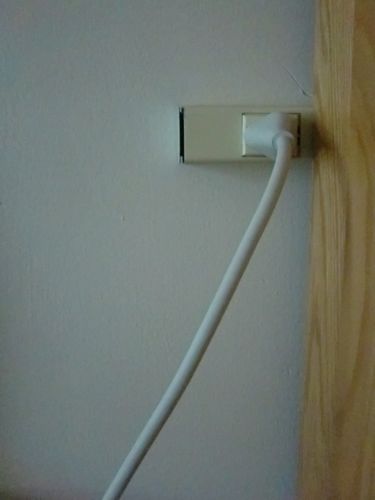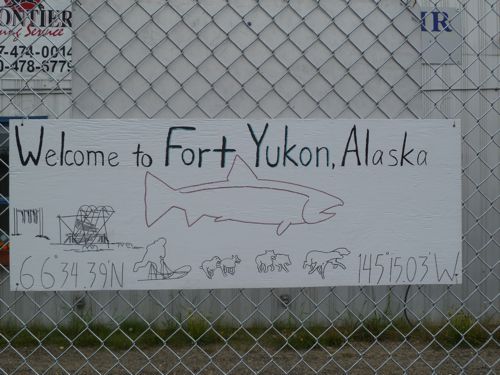We're back in Fairbanks where the electrons flow like water (or, perhaps, just like electrons!) from that funny little thing that is attached to the wall of my dormitory room here at the University of Alaska, Fairbanks campus. Today is a day for drying and re-packing gear, catching up and updating journals and photographs (I will be adding some pictures and 'new and improved' text to some of the journals), and relaxing.
 The electrons flow like water!
The electrons flow like water!
The transition from the field to what some call the civilized world is often a bit abrupt. It is even more abrupt when you are magically transported from the proverbial middle of nowhere to the relatively middle of somewhere known as Fairbanks in the matter of 5 hours. The miracle of concentrated fossil fuels! It's certainly a bit different from the miners and trappers who travelled across the tundra by foot or dogsled. While the fuel that powered our rapid journey began as sunlight, it has undergone slightly more modification over a much longer period of time than the sunlight-trapping food the miners and trappers used for fuel.
Our morning in camp was soggy and grey, after an all-night misty rain. The clouds, however, were quite a bit higher and not as thick as those from the previous day, so we were fairly confident that Kirk, our pilot, would be able to pick us up. The plan was to wait until we had phone confirmation for an approximate pickup time before we started the process of packing and hauling gear to the landing strip. At 10 the call came through--he would be at Mancha Creek around 1pm. Hard to believe that less than 12 hours later I would be sitting in a dormitory room in Fairbanks after a nice long shower to wash away the film of DEET + dirt with my tent hanging to dry, my laundry washed and dried, and pizza digesting in my stomach!
It took Kevin and me two trips to haul our gear from our gravel bar camp to the landing strip. In case you are picturing a paved, smooth landing strip, you should erase that vision from your brain. The phrase landing strip is, perhaps, an exaggeration. It's more like a short, relatively flat, piece of tundra--just long enough for Kirk to land his plane and take off again. It was, perhaps, 300 feet long and was marked with a couple piles of rocks at each end that showed where there were 3-foot drops to some old ponds. The landing strips from Mancha Creek to Fairbanks paralleled our return to civilization as they changed from tundra to gravel to pavement.
 Kirk's plane on the tundra. The pile of rocks by the front tire is one of the markers he used.
Kirk's plane on the tundra. The pile of rocks by the front tire is one of the markers he used.
Due to the diminutive nature of our landing strip, Kirk actually made two trips to remove us from our camp. He came in the day before and left with Angie and some of our gear. The weather forecast had not been optimistic (unless you're hoping for rainy, stormy weather) and Kirk wanted to make sure we got out. While taking off from Arctic Village with a heavy load last week wasn't a problem, taking off from Mancha Creek would have been an issue with three people and gear. He would have had to take one person and gear to a longer landing strip, land, unload, then return for the other two and gear, then fly back to the longer strip, reload, and take off with all of us. It sounds sort of like the makings for a riddle--definitely a real world application of concrete sequential thinking and the necessity for pre-planning.
 The view east as we took off.
The view east as we took off.
Kirk flew us to Fort Yukon, about 1 1/2 hours away and 8 miles north of the Arctic Circle. We landed on the 5,800-foot long gravel airstrip around 3pm with plenty of time to catch the 3:45 flight to Fairbanks. Fort Yukon lies at the confluence of Yukon and Porcupine Rivers. It was founded in 1847 as a Canadian outpost in what was at that time Russian territory and in the heart of Gwich'in Indian lands. The Hudson Bay Company had a post in Fort Yukon from 1846 to 1869. After the United States bought Alaska in 1867 the Alaska Commercial Company took over operation of the Trading Post. The town has endured its ups and downs, including the Klondike Gold Rush, epidemics brought in by introduced disease, and floods. It was incorporated as a city in 1959.
 Welcome to Fort Yukon!
Welcome to Fort Yukon!
 Too bad we weren't here when the deli was open. The biggest surprise about the nachos might have been the price!
Too bad we weren't here when the deli was open. The biggest surprise about the nachos might have been the price!
Our flight to Fairbanks was smooth and all-too-soon we landed on the pavement under cloudy and drizzly skies. Once you hit the pavement, life seems to move at a much faster pace. In a matter of minutes we collected our gear, got in a taxi, were taken to our rental car, and moved the bags into the trunk. After a quick stop at Fred Meyer for some snacks and laundry soap, we headed to the UAF campus, got the keys to our rooms, hauled those bags of gear one more time (with elevator-assist) and were in our rooms by 7pm. Welcome to Fairbanks!
 Welcome to Fairbanks.
Welcome to Fairbanks.
